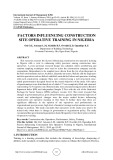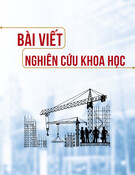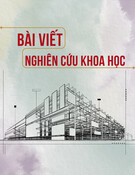
http://www.iaeme.com/IJM/index.asp 83 editor@iaeme.com
International Journal of Management (IJM)
Volume 10, Issue 1, January–February 2018, pp.83–93, Article ID: IJM_10_01_012
Available online at http://www.iaeme.com/ijm/issues.asp?JType=IJM&VType=10&IType=1
Journal Impact Factor (2018): 9.1550 (Calculated by GISI) www.jifactor.com
ISSN Print: 0976-6502 and ISSN Online: 0976-6510
© IAEME Publication
FACTORS INFLUENCING CONSTRUCTION
SITE OPERATIVE TRAINING IN NIGERIA
Oni O.Z, Amusan L.M, Akinbile B.F, Owolabi J.D, Ogundipe K.E
Department of Building Technology
Covenant University, Ota, Ogun State, Nigeria.
ABSTRACT
This research assesses the factors influencing construction site operative training
in Nigeria with a view to enhancing safety practices among construction sites
operatives. A cross-sectional research design was adopted, where snowballing and
random sampling techniques were used to select the construction company and the
respondents. Respondents to be sampled were drawn from the list of professionals in
the built environments such as Architect, Quantity surveyors, Builder and the Engineers
and site operatives such as skilled, unskilled, semi-skilled labors and operators working
with each construction company. Data were collected using a well-structured close-
ended questionnaires designed based on the stated objectives of the study. 188 copies
of questionnaires were distributed out of which 137 was completely filled and returned,
representing 72.9 response rate. Returned data were analyzed using percentile, Relative
Important Index (RII) and independent Sample T-Test with the aid of the Statistical
Package for Social Science (SPSS) software version 21.0. The result revealed that
changes in government policy, poor job performance, quality improvement, high rate of
rework and technological changes were the major ranked factors influencing
construction site operative training in Oyo State. It further show that there are
significant difference in the opinion of site operatives and professionals on
organizational peer pressure, high level of material wastage and promotion exercise or
change in position. The study concludes that operatives in the study area tend to be
trained only when there is change in government or organization policy. The study
recommend that government/organization should frequently review there policy in favor
of operative training.
Key words: Construction site, Operatives, Performance, Safety, Training
Cite this Article: Oni O.Z, Amusan L.M, Akinbile B.F, Owolabi J.D, Ogundipe K.E,
Factors Influencing Construction Site Operative Training in Nigeria, International
Journal of Management, 10 (1), 2019, pp. 83–93.
http://www.iaeme.com/IJM/issues.asp?JType=IJM&VType=10&IType=1
1. INTRODUCTION
Training is a learning procedure that includes the obtaining of knowledge, sharpening of
abilities, skill, standards, or modifying mindset plus conduct to enhance the employee efficency.





















